I’ve recently gotten a new phone – a HTC Sensation running Android 2.3, and I thought I’d offer up a few thoughts on it. But first…
Hang on: what was wrong with your old phone?
Well-remembered! You’re right, of course, that last year I got a Nokia N900, and that it was the best mobile communications device I’d ever owned. I don’t care so much about a slim profile or an “app store”, but I do care about raw power and geeky hardware features, and the N900 delivers both of those in spades. I’ve had several phones that have, at the time, been the “best phone I’ve ever owned” – my 7110 and my N96 both also earned that distinction, whereas my 7610 and my C550 – the latter of which had only one redeeming feature – fell far short.
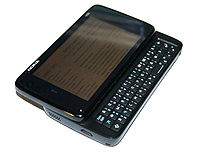
Awesome though it is, with it’s beautiful hardware keyboard, mighty processor, FM receiver and transmitter, Bluetooth and IR, etc., and completely unlocked, tamper-friendly architecture, the N900 suffers from one terrible, terrible flaw: for some reason, the engineers who built it decided to mount the Micro-B USB port (used for charging, tethering, mounting etc. the phone) not to the hard plastic case, but to the fragile inner circuit board. Allow me to illustrate:
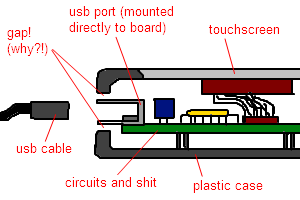
Why is this a problem? Well, as Katie explained to me at the New Earth housewarming party, most of her other friends who’d had N900s had encountered a problem by now, whereby the USB cable used to charge the device eventually puts a strain on the connection between the port and the board, tearing them apart. “Nope,” I told her, “I’ve never had any such problem with mine.”
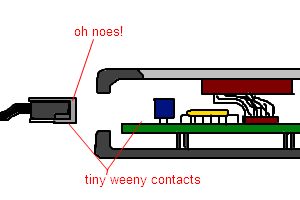
Looks like I spoke too soon, because that very week, I managed to break my N900 in exactly this way. My theory: that girl is cursed. I shall be attempting to exorcise the anti-technology demons in her the very next time I see her, possibly in some kind of ceremony involving high-voltage direct current. In any case, I found myself with a phone that I couldn’t charge.
So you replaced it?
No, of course not. My N900 remains a fantastic palmtop and a great device. It’s just got a minor problem in that it’s no longer possible to charge or “hard”-tether it to anything any more. The latter problem was an easy one to fix: a separate battery charger (I already carry a spare battery for it, so this was no hardship), bought for about £4 on eBay, made it easy to keep the device rolling. The second problem’s not so much of an issue, because I tend to do all of my synchronisation by Bluetooth and WiFi anyway. But even if these were an issue, it looks like a pretty simple job to re-solder the USB port (and epoxy it to the case, as it should have been to begin with!). I might give it a go, some day, but my current soldering iron is a little big and chunky for such fine and delicate work, and I’m a little out of practice, so I’ll save that project for another day.

However, I’m a big believer in the idea that when the Universe wants you to have a new phone, it finds a fault with your current phone. Perhaps this is the geek equivalent of thinking that “When God closes a door, He opens a window”.
So: I’ve got myself a HTC Sensation, which narrowly beat the Sony Ericsson Xperia Arc after carefully weighing up the reviews. I’d always planned that I’d try an Android device next, but I’d originally not expected to do so until Ice Cream Sandwich, later this year. But… when the Universe closes your USB Port, it opens a Gingerbread shop… right?
The New Sensation
After a few difficulties relating to my name – it turns out that my mobile phone network has recorded my name correctly in their database, and I can’t change it, but whenever I use their web-based checkout it asks me to enter a longer surname even though I don’t have a surname field to change – I finally received my new phone.

The first thing one notices about this phone is that it’s fast. Blindingly fast. I’ve used a variety of Android-powered HTC devices before, as well as other modern touchscreen smartphones like the iPhone, and I’m yet to use anything that consistently ramps up high-end graphics and remains slick and responsive like this does. Its mighty dual-core 1.2GHz processor’s the cause of this, little doubt. I originally worried that battery life might be limited as a result – I don’t mind charging my phone every night, but I don’t want to have to charge it during the day too! – but it’s actually been really good. Using WiFi, GPRS, GPS, playing videos, surfing the web, and other “everyday” tasks don’t put a dent in the battery: I’ve only once seen it dip to under 10% battery remaining, and that was after 40 hours of typical use during a recent camping weekend (with no access to electricity).
It’s also been really well-designed from a usability perspective, too. Those familiar with Android would probably just start using it, but I’ve not had so much exposure to the platform and was able to come to it with completely fresh eyes. Between Android 2.3 and HTC Sense 3, there’s a nice suite of “obvious” apps, and I didn’t have any difficulty synchronising my contacts, hooking up my various email accounts, and so on. There are some really nice “smart” touches, like that the phone rings loudly if it thinks it’s in a bag or pocket, more quietly after you pick it up, and silences the ringer completely if you pick it up from a table and flip it from face-up to face-down. These simple gestural touches are a really nice bit of user interface design, and I appreciate the thought that’s gone into them.
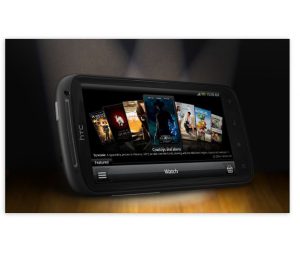
The Android Marketplace is reasonable, although I feel as though I’ve been spoiled. On the N900, if there was an application I needed, I usually already knew what it was and where I’d find it: then I’d either apt-get it, or download the source and compile it, right there on the device. For somebody who’s already perfectly confident at a *nix command-line, the N900 is fab, and it feels a little restrictive to have to find equivalent apps in a closed-source environment. It’s not that the pricing is unreasonable – most of the applications I’ve wanted have been under a quid, and all have been under £4 – it’s just that I know that there are FOSS alternatives that would have been easy to compile on my old device: I guess it’s just a transition.
On the other hand, the sheer volume of applications so-easily available as the Android Market is staggering. I’ve been filled with app ideas, but every idea I’ve had but one or two already exist and are just waiting to be installed. It’s a little like being a kid in a candy store.
It’s also taking me quite some time to get used to the way that process management works on an Android device. On Android devices, like the iPhone/iPad, returning to the home screen doesn’t (necessarily) close the application, but it might – that’s up to the developer. If it doesn’t, the application will probably be “paused” (unless it’s a media player or it’s downloading or something, then it’ll likely keep going in the background). And when you re-launch the same application, it could be simply unpausing, or perhaps it’s relaunching (in which case it may or may not restore its previous state, depending on the whim of the developer)… You see all of the keywords there: might, probably, likely, could, perhaps. Great for most users, who don’t want to have to think about what their phone is doing in the background, but it feels like a step backwards to me: I’m used to being able to ALT-TAB between my currently-running applications, to know what’s running, when (and I can always use top and find out exactly what resources a process is eating). Putting all of this process management into the hands of developers feels to me like giving up control of my device, and it’s a challenging change to undergo. Yes: despite the openness of the platform, Android feels just a little out of my control compared to what I’m used to.
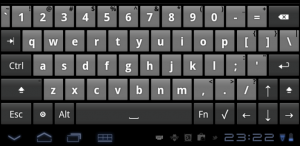
Switching from a physical to a virtual keyboard for the first time is a significant change, too, and it’s slowed me down quite a lot, although applications like SwiftKey X – with its incredibly intelligent personalised predictions – and Hacker’s Keyboard – which gives me back some of the keys I was “missing” – have helped to ease the transition a lot.
In summary: the HTC Sensation seems to be a fantastic device, and I’m really enjoying using it. I’ve got a few niggles to contend with, but these are all things that were destined to catch me out upon switching away from a platform as open as the N900, and they’re not severe enough to make me give up and get an N950 instead: I’m reasonably confident that I’ll come to love the Sensation and we’ll go on to be very happy together.
But will it become my latest “best phone ever”? Time will tell, I guess.
I’m bemused that you even have to think about process management on your phone, it’s time to let go ;)
Have to? No. *Want* to? Yes. It’s a geek thing, I just want to be in control of the absolute maximum amount of my computers as I can be – in theory at least.
Anal-retentive, perhaps? Yes.
Very yes ;)
I believe the proximity sensor also automatically switches off (or dims) the screen if the phone is held up against something – for example when making a phone call…
Indeed it does, but that’s not a “new” feature to me: my last few phones have all done that, too. Not that it isn’t a fab feature; it’s just nothing new to me.
“I shall be attempting to exorcise the anti-technology demons in her the very next time I see her, possibly in some kind of ceremony involving high-voltage direct current.”
Um. You mean ‘High frequency alternating current,’ surely? Otherwise you don’t get the skin effect so much as a serious risk of death…
Nice post, though. Standard Safety Compliance aside, good to know the Sensation is nice. My poor little Hero is getting decidedly tired, and since August has magically turned up in no bloody time at all, I’m almost due for an upgrade…
Whatever he means, I’m now slightly nervous o.O ;)
I’m looking out for a new phone and the Samsung Galaxy S II was what seemed best – any reason you chose the Sensation instead (the keyboard, perhaps)?
The deciding factors that weighed the Sensation in above the Galaxy S II was that the former seems to be of a sturdier construction and that HTC Sense seems to be a lot “smarter” in its design than TouchWiz. It was a close thing, though. The major selling point for the Galaxy S II that was significantly better than the Sensation was that it’ll have NFC support, but it turns out that the UK edition won’t have the chipset for NFC until later in the year.
How did I get here?
While lying in bed, unwell and off work, last month, I found myself surfing (on my new phone) to the Wikipedia page on torsion springs. And that’s when I found myself wondering – how did I get here?
Thankfully, there’s always the back button: famously the second most-used bit of your web browser’s user interface. So… how did I come to be reading about torsion springs?
An anniversary clock, using a torsion pendulum, so-named because it only needs winding once a year.I got there from reading about torsion pendulum clocks. My grandmother used to have one of these (an “anniversary clock”, like the one above, and I remember that I used to always enjoy watching the balls spin when I was a child).
I’d followed a link from the article about the Atmos clock, a type of torsion pendulum clock that uses minute variations in atmospheric temperature and pressure to power the winder and which, in ideal circumstances, will never need winding.
Before that, I’d been reading about the Beverly Clock, a classic timepiece that’s another example of an atmospheric-pressure-clock. It’s been running for almost 150 years despite having never been wound.
This was an example of another long-running experiment given on the page about the Oxford Electric Bell, which is perhaps the world’s longest-running scientific experiment. Built in 1840, it uses a pair of electrostatic batteries to continuously ring a bell.
The Oxford Electric Bell experiment. It’s batteries have lasted for over 160 years, but I have to charge my mobile most nights: what gives, science?I got to the Oxford Electric Bell from another long-running experiment – the one acknowledged as the world’s longest-running by the Guinness Book of Records – the University of Queensland Pitch Drop Experiment. Running since 1927, this experiment demonstrates that pitch is not solid but a high-viscosity fluid. A sample of room-temperature pitch in a funnel forms a droplet about once a decade.
Earlier, I was learning about the difference between the different substances we call tar. Traditionally, tar is derived by baking pine wood and roots into charcoal, and collecting the runoff, but we also use the word “tar” to describe coal tar (a byproduct of coke production) and bitumen (viscous, sticky crude oil).
I took the initiative to learn about those differences after reading about the name “Jack Tar“, an Empire-era slang term for a sailor in the Merchant Navy or Royal Navy…
…which in turn was linked from the similar article about “Tommy Atkins“, a term for a British infantryman (particularly in the First World War), which has an interesting history…
…to which I got from the “Doughboy” article. The Doughboys were members of the American Expeditionary Force during the First World War.
R.U.R. – “Private Robot” – loads an artillery piece.Finally, I got to that first Wikipedia article while, when reading an article on The Paleofuture Blog, I wondered about the etymology of the term “doughboy”, and began this whole link-clicking adventure.
It’s fascinating to work out “how you got here” after an extended exploration of a site like Wikipedia (or TV Tropes, or Changing Minds, or Uncyclopedia – and there goes your weekend…). Thank you, Back Button.
I just wish I had a Back Button in my head so that I could “wind back” my wandering thought processes. How did I end up thinking about the salt content of airline food, exactly?
Read more →